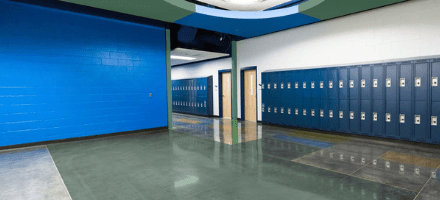Colored concrete has been a popular choice for exterior residential projects for decades. You’re bound to see at least a few colorful driveways or patios on any given neighborhood street. In recent years, this material has found favor everywhere from commercial reception halls to finished home basements.
Today, we’re talking through concrete dyes vs. stains. Is there a clear winner for a particular project? How do you figure out what you should use? Read on for some insight into the wonderful world of colored concrete.
CONCRETE STAIN VS. CONCRETE DYE
These terms cover a variety of products, and the right choice will depend on the state of the concrete surface you’re working on, as well as your desired end result. So, what’s the difference between concrete stain and concrete dye?
When it comes to concrete stain vs. dye, the main difference is that a stain will chemically react with the concrete, while a dye will simply permeate the material. Read on for more specifics.
CONCRETE STAIN
Acid-based chemical stains react with the minerals that make up a concrete slab. The end result is an etched surface in a range of earthy tones. Add a stamped design, and you can create the look of anything from natural stone to polished marble to stained wood.
These stains are semi-transparent, however, so be advised that they won’t cover any cracks or preexisting color. Proper surface preparation is key to any project, but it’s especially important when you’re using acid-based chemical stains.
If your stained concrete project calls for something other than earth tones, but you still want the stability and durability of a concrete stain, you can opt for a water-based acrylic stain. This type of product also penetrates concrete and can be found in a range of colors.
Overall, concrete stains work wonderfully on both interior and exterior projects. They hold up under UV exposure and normal wear and tear. Finally, while they have a fixed color range, they can be used to create some truly stunning translucent designs and patterns.
CONCRETE DYE
Concrete dyes don’t react chemically to concrete—in other words, there’s not as much educated guessing going on when you apply a dye as there is when you apply a stain. Because dyes don’t bond to concrete, the color that comes out of the packaging is the color you’ll get, within reason.
Concrete is porous on its own, and the dye is made up of exceedingly tiny particles that will penetrate the surface, creating a striking end result. This process happens quite quickly, though, which means that there isn’t very much room for error. You’d better have a game plan in place before getting started!
Concrete dyes are either water or solvent-based, and they’re typically available as a powder, in solution, or as a liquid concentrate. Their color range is virtually limitless—but mixing and arriving at the proper hue is up to you. Finally, they don’t hold up well under ultraviolet light, so they’re either best kept for interior projects or used with a UV sealer.
CHOOSING THE BEST PRODUCT FOR YOUR DYED OR STAINED CONCRETE PROJECT
In some cases, you can actually use both a concrete stain and a concrete dye to achieve a unique concrete tint. That said, what is the best way to go about choosing one or the other?
Here are a few tips…
CHOOSE A CONCRETE STAIN IF:
- You’re working on an exterior surface. Stains are better able to withstand ultraviolet light and are also less likely to wash away when exposed to the elements. If you’re set on using a dye, you’ll need to apply a UV sealer—even if your installation is located indoors!
- You want to imitate another material, such as polished marble or tanned leather.
- The chosen color palette calls for earthy tones, such as terra cotta or tan.
CHOOSE A CONCRETE DYE IF:
- A project requires a wide range of colors or a unique hue, and you have enough knowledge of color theory to properly mix colors. The last thing you want is to end up with a muddy color and an unhappy customer.
- You want to add a subtle effect to an acid-stained concrete project.
- The floor design calls for a layered, variegated effect.
- Your customer wants a floor with bold hues. Dyes can also be diluted to create a lighter, more watercolor-esque effect.
- You’re working on a tight timeline. Dyes leave no residue behind, allowing for quick cleanup and overall faster application.
ALL THE CONCRETE EQUIPMENT AND ACCESSORIES YOU NEED TO INSTALL A DECORATIVE CONCRETE FLOOR
Whether you’re going the acid-stained concrete route or you’re evaluating your choices of dye, the surface prep and concrete finishing experts at Runyon Surface Prep are here to help! From delivering products directly to job sites to diagnosing and solving equipment troubles, we’re ready to assist you at any stage of a project.
Give us a call today to talk through some concrete stain or dye options—or to chat about anything else you might need for a high-quality installation. We look forward to working with you.
